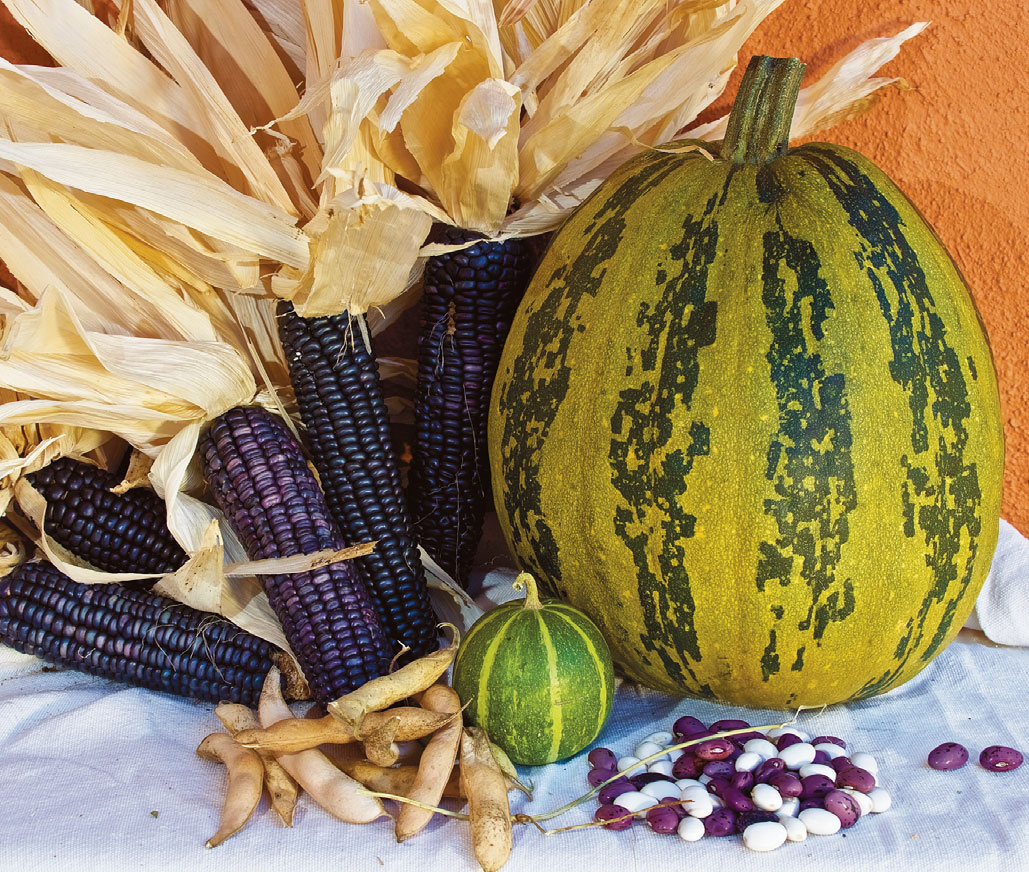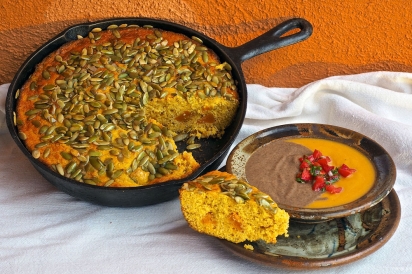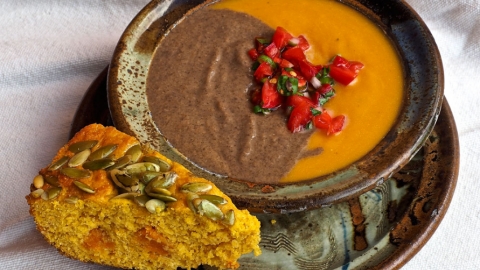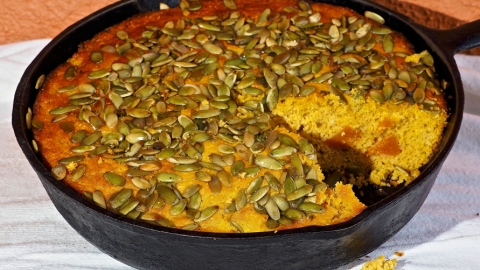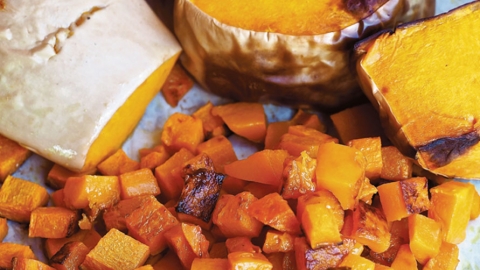Food With a Story to Tell: The Three Sisters
It is said that the earth began when “Sky Woman,” who lived in the upper world, peered through a hole in the sky and fell through to an endless sea. The animals saw her coming, so they took the soil from the bottom of the sea and spread it onto the back of a giant turtle to provide a safe place for her to land. This “Turtle Island” is now what we call North America.
Sky Woman had become pregnant before she fell. When she landed, she gave birth to a daughter. When the daughter grew into a young woman, she also became pregnant (by the west wind). She died while giving birth to twin boys. Sky Woman buried her daughter in the “new earth.” From her grave grew three sacred plants—corn, beans, and squash. These plants provided food for her sons, and later, for all of humanity. These special gifts ensured the survival of the Iroquois people.
—Diana Erney in “Long Live the Three Sisters,” Organic Gardening, November 1996.
The ethno-botanical story of the Three Sisters spans over 10,000 years. It began when humans migrated into the Americas and began to develop agriculture. We wouldn’t have recognized those long-ago ancestors of today’s corn, beans and squash. What helped them along is natural diversity, the tendency for every plant to be a little different. By selecting plants with more desired qualities and planting their seeds, early farmers developed the food plants that we now eat over generations.
The origins of corn are with a bushy tropical grass found in Southern Mexico called teosinte. An ear of teosinte is about three inches long and has seven to 10 hard-shell kernels. Over the millennia humans chose bigger and bigger cobs (the Hopi Blue Corn I grew this year had ears over 12 inches long), more kernels (now corn ears have over 500 kernels), more tender skins and more tolerance for diverse climates. Eventually this highly productive giant grass flourished all over the Americas and all over the world.
In Pleistocene North America before humans appeared, giant mammoths roamed the Americas. They ate squash much like the wild Buffalo or Coyote Gourd that is still found in the Southwest—a small, hard-shelled, bitter and somewhat poisonous three-inch orb. Researchers at Penn State found squash seeds in mammoth droppings, the perfect medium for nourishing the new plant. Mammoths didn’t taste the bitterness, they weren’t affected by the hard shell or the poisons and they found the gourds to be a lovely shape for munching and playing ball. As humans arrived (and mammoths disappeared) they found the wild gourds good for holding food and drink. First cultivated for use as containers, the bitter gourds were gradually selected as a bigger, sweeter, less bitter, more tender and non-poisonous food. The modern results are “summer squash,” immature fruit (like zucchini) selected for tenderness, and “winter squash” (like butternut and pumpkin) with a hard shell, selected for good keeping qualities, rich, nutty flavor and sweetness.
The wild beans of the Americas are thin climbing vines that produce seeds the size of a grain of rice. Wild bean pods rupture as soon as they are dry, shooting seeds far and wide, which makes them really hard to gather. Humans have selected plants for larger, sturdier, more productive beans with pods that resist shattering.
Three Sisters Planting and Nutritional Synergy
Corn, beans and squash planted together complement each other. Corn serves as the support for climbing beans. Beans set nitrogen in the soil that corn and squash require to grow. And squash spreads out, covering the soil to discourage competitive weeds and cooling the soil to reduce evaporation. Early agriculturists copied this companion-planting system from nature and used it in their gardens.
The Three Sisters are also nutritional companions. Corn, beans and squash seeds (including pumpkin seeds) provide a full complement of essential amino acids resulting in high-quality protein equal to that of meat. Squash is nutrient dense with especially high quantities of beta-carotene, the precursor to vitamin A. Dr. Jane Mt. Pleasant, an agricultural scientist at Cornell University who is of Tuscarora heritage, found that corn, beans and squash planted together yield more calories and protein and will feed more people than the three grown separately.
The Three Sisters planting system produced abundance, health and strong populations. These crops store so well that seeds found in ruins are still viable after hundreds of years. They acted as insurance against natural disasters and climate fluctuations. Corn, beans, dried squash and squash seeds are easy to carry and can be rehydrated into exceptionally nourishing foods, allowing people to explore and move into new territory. They gave people the security to work on improvements like great buildings, irrigation systems, medicine, art, metallurgy and astronomy. They laid the foundation for the great civilizations of the Americas: Aztec, Toltec, Mayan, Inca, Pueblo and Haudenosaunee (Iroquois).
The Three Sisters Come to Visit and Stay for Dinner
Last summer I tested the system out in my own garden. I went Three Sisters crazy and planted a 12- by 80-foot bed with two varieties of heritage corn and beans and four varieties of heritage squash. We covered the bed with a generous topping of composted horse manure. It was a good year: plentiful rain, minimal insect and javelina invasions and no hail. The result was an explosion of abundance. I am gifting, donating, baking, drying, canning and freezing corn, beans and squash. I feel rich beyond words.
Even if you don’t have the time or space to grow the Sisters you can invite them to dinner regularly. It’s winter now, the best time of year for a simple Three Sisters meal: Bean and Squash Soups Married Together, Lighthouse Salsa and Roasted Squash Pumpkin Seed Cornbread.
Chef Molly Beverly is a food activist, teacher, caterer, food coach, chair of Slow Food Prescott and former chef of Crossroads Café in Prescott.
Three Sisters Garden
I hope you get the chance to experience the joy of watching the Three Sisters grow and produce in your own garden. An excellent planting guide and seeds are available from Native Seeds/SEARCH. See nativeseeds.org/learn/gardening, How to Grow a Three Sisters Garden.


